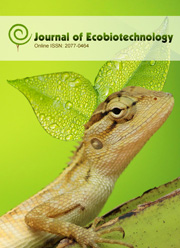Optimization of Culture Conditions for the Production of Extracellular Cellulase from Corynebacterium lipophiloflavum
Abstract
Cellulolytic enzyme producing bacteria were isolated from decaying vegetables on nutrient agar plates. As many as fourteen different bacterial strains were isolated and they were screened for the production of cellulase enzyme on a medium containing carboxymethyl cellulose (0.5% w/v). A Congo red dye based qualitative assay was performed to identify cellulase producing bacteria isolated from the vegetables. Among the difference strains, after screening on CMC agar, one strain exhibited relatively higher cellulase activity and was identified as Cornybacterium lipophiloflavum by a bacteriologist. Culture conditions were optimized for the above bacterium in the production medium supplemented with different carbon and nitrogen sources, different pH and different concentrations of CMC. Glucose and yeast extract proved to be the suitable carbon and nitrogen sources while pH 7.0 was ideal for cellulase production by the bacterium. Carboxymethyl cellulose at 1% in the medium induced relatively higher cellulase activity. Electrophoretic analysis of the ammonium sulfate precipitated proteins showed three prominent bands and whose molecular masses were estimated as 60, 69 and 75 kDa. Cellulase produced by Cornybacterium lipophiloflavum could efficiently remove dyes or inks from the pulp incubated either in the form of intact growing cell or with clarified supernatant. The enzyme also removed starch from the fabric incubated with culture supernatant suggesting the potential use of Cornybacterium lipophiloflavum cellulase in industrial applications.Downloads
Download data is not yet available.
Published
23-12-2010
How to Cite
Jayaveny and P. Palani*, M. S. N. K. R. “Optimization of Culture Conditions for the Production of Extracellular Cellulase from Corynebacterium Lipophiloflavum”. Journal of Ecobiotechnology, vol. 2, no. 9, Dec. 2010, https://updatepublishing.com/journal/index.php/jebt/article/view/100.
Issue
Section
Microbial Biotechnology



 .
.